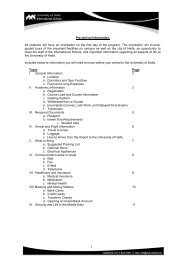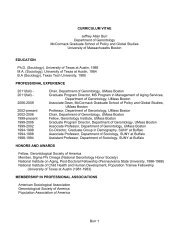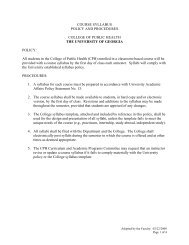2007/2008 CPH Magazine - College of Public Health - University of ...
2007/2008 CPH Magazine - College of Public Health - University of ...
2007/2008 CPH Magazine - College of Public Health - University of ...
You also want an ePaper? Increase the reach of your titles
YUMPU automatically turns print PDFs into web optimized ePapers that Google loves.
<strong>Health</strong> Promotion and BehaviorLighten Up: Weight Management in the WorkplaceOne in four adult Georgians is obese.That’s what the Georgia Department <strong>of</strong> Human Resourcesfound in a 2006 study. The study also showed that the percentage<strong>of</strong> obese adults in all areas <strong>of</strong> the state has skyrocketed since1993, that only two in five adults are regularly active and thatobesity costs Georgia around $2.1 billion a year in both directand indirect healthcare costs.What to do? Well, you can’t change genetics, but you canchange behavior, and that’s what the Workplace <strong>Health</strong> Groupin the <strong>College</strong> <strong>of</strong> <strong>Public</strong> <strong>Health</strong> is trying to do.Along with principal investigator Ron Goetzel <strong>of</strong> Cornell<strong>University</strong>, Group director David DeJoy and MarkWilson, head <strong>of</strong> the Department <strong>of</strong> <strong>Health</strong> Promotion andBehavior, are in the middle <strong>of</strong> a $4.5 million grant projectthat has designed interventions to help people managetheir weight in the workplace.“This project focuses not only on the individual butalso the environment in which they live and interact,” saysHeather Bowen, project manager for the Workplace <strong>Health</strong>Group. “We have realized that we can’t just tell them whatto do. We must also make their surroundings conducive tothe changes that we are recommending.”OBESITY costs Georgiaaround $2.1 billion a yearin both direct and indirecthealthcare costs.In other words, it’s hard to preach the virtues <strong>of</strong> healthysnacking when an employee’s only option is the high fat,high sugar snacks lurking in the vending machine down thehall.Tested by over 6,000 Dow Chemical plant employeesin Texas, Louisiana, West Virginia and New Jersey, the interventionsincluded healthier vending machine, cafeteriaand catering choices; signage addressing physical activity,nutrition and weight management; on-site walking paths;an individual weight management tracking program; and,<strong>of</strong> course, rewards and recognition for healthy progress.Results are still being analyzed, but Bowen says thatmost <strong>of</strong> the interventions could easily be used in other settings,such as schools. While the workplace was chosenfor the ability <strong>of</strong> reaching a large group <strong>of</strong> people, Bowenhopes that the interventions’ influence will filter to homeand beyond.“Although the home environment is a very importantpiece <strong>of</strong> the puzzle, most <strong>of</strong> us eat more than two <strong>of</strong> ourthree meals away from home,” she says.—Mary Jessica Hammes14 <strong>College</strong> <strong>of</strong> <strong>Public</strong> <strong>Health</strong>
















